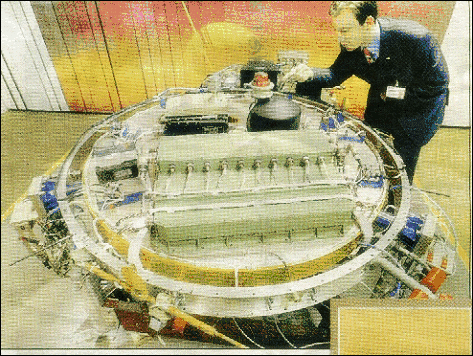Titan to Earth: We have touchdown
Dato' Dzulkifli Abd Razak
The saucer-shaped probe completed its final hours of a 2.2 billion-mile mission to Titan.
Huygens detached from the Cassini spacecraft around Christmas Day and spun silently toward Titan. Cassini is expected to remain in orbit around Saturn until at least July 2008.
The spacecraft crossed Saturn's rings in June 2004 and sent revealing photos of the rings composed primarily of hydrogen and helium.
Saturn is the sixth planet from the Sun with 33 known moons. Titan, the largest, is said to be larger than Pluto.
This week, streams of images were transmitted from the probe to Earth, making it a historic experience in that not only it is regarded an engineering and scientific success, but it also presents a rare opportunity for us to understand how life began on Earth.
This is because Titan's atmosphere consists of a mixture of nitrogen, methane, argon and other organic compounds, which resemble Earth's condition more than 3.8 billion years ago.
The early images showed some similarities to Earth, and also the red planet, Mars — indication of a commonality in the solar system.
Scientists with the Cassini-Huygens mission have been hopeful that the mission will help answer where life came from, though some cautioned that finding living organisms was remote.
Huygens carried a sound recorder and a lamp to look for signs of surface liquid.
Titan is said to be to be very cold due to a lack of sunlight, and this has put it "into a deep-freeze, hindering chemical reactions needed for organic life".
Temperatures on Titan hover around minus 180 Celsius, immediately freezing any liquid surface water.
It is said to be the only moon in the solar system to retain a substantial atmosphere, one even thicker than Earth's.

Article
New Sunday Times - 01/23/2005
As our eyes are fixed on the ground, mesmerised by the unfolding events following the recent tsunami, many would have missed an equally mesmerising event that took place in the outer space last week.
The historic event occurred last Saturday evening, when an European-made space probe, Huygens, landed on the surface of Saturn's largest moon Titan.
New Sunday Times - 01/23/2005
As our eyes are fixed on the ground, mesmerised by the unfolding events following the recent tsunami, many would have missed an equally mesmerising event that took place in the outer space last week.
The historic event occurred last Saturday evening, when an European-made space probe, Huygens, landed on the surface of Saturn's largest moon Titan.

Pioneering Probe: European Space Agency communicatios officer Bernhard von Weyhe standing next to a model of the Huygens probe at the European Space Operations Centre in Darmstadt, central Germany, on Jan 14. - AP picture
The saucer-shaped probe completed its final hours of a 2.2 billion-mile mission to Titan.
Huygens detached from the Cassini spacecraft around Christmas Day and spun silently toward Titan. Cassini is expected to remain in orbit around Saturn until at least July 2008.
The spacecraft crossed Saturn's rings in June 2004 and sent revealing photos of the rings composed primarily of hydrogen and helium.
Saturn is the sixth planet from the Sun with 33 known moons. Titan, the largest, is said to be larger than Pluto.
This week, streams of images were transmitted from the probe to Earth, making it a historic experience in that not only it is regarded an engineering and scientific success, but it also presents a rare opportunity for us to understand how life began on Earth.
This is because Titan's atmosphere consists of a mixture of nitrogen, methane, argon and other organic compounds, which resemble Earth's condition more than 3.8 billion years ago.
The early images showed some similarities to Earth, and also the red planet, Mars — indication of a commonality in the solar system.
Scientists with the Cassini-Huygens mission have been hopeful that the mission will help answer where life came from, though some cautioned that finding living organisms was remote.
Huygens carried a sound recorder and a lamp to look for signs of surface liquid.
Titan is said to be to be very cold due to a lack of sunlight, and this has put it "into a deep-freeze, hindering chemical reactions needed for organic life".
Temperatures on Titan hover around minus 180 Celsius, immediately freezing any liquid surface water.
It is said to be the only moon in the solar system to retain a substantial atmosphere, one even thicker than Earth's.

TItan's Charm: This image was returned Jan 14 by the European Space agency's (ESA) Huygens probe during its successful descent to land on Titan. This coloured view, following processing to add reflection spectra date, gives a better indication of the actual colour of the surface. Initially thought to be rocks or ice blocks, they are more pebble-sized. - Reuters picture
The US$3.3 billion Cassini-Huygens mission launched in 1997 involves the American and European space agencies.
On the local scene, history was also made during the weekend.
Firstly, it marked the largest gathering of telescopes in Malaysia, with 135 placed at the Universiti Sains Malaysia's parade.
Secondly, in the process, Malaysia became the first country outside Britain to remotely use and control one of the world's largest telescope in the Hawaiian island of Maui, The Faulkes Telescope ( www.faulkes-tele-scope.com ).
On the local scene, history was also made during the weekend.
Firstly, it marked the largest gathering of telescopes in Malaysia, with 135 placed at the Universiti Sains Malaysia's parade.
Secondly, in the process, Malaysia became the first country outside Britain to remotely use and control one of the world's largest telescope in the Hawaiian island of Maui, The Faulkes Telescope ( www.faulkes-tele-scope.com ).
